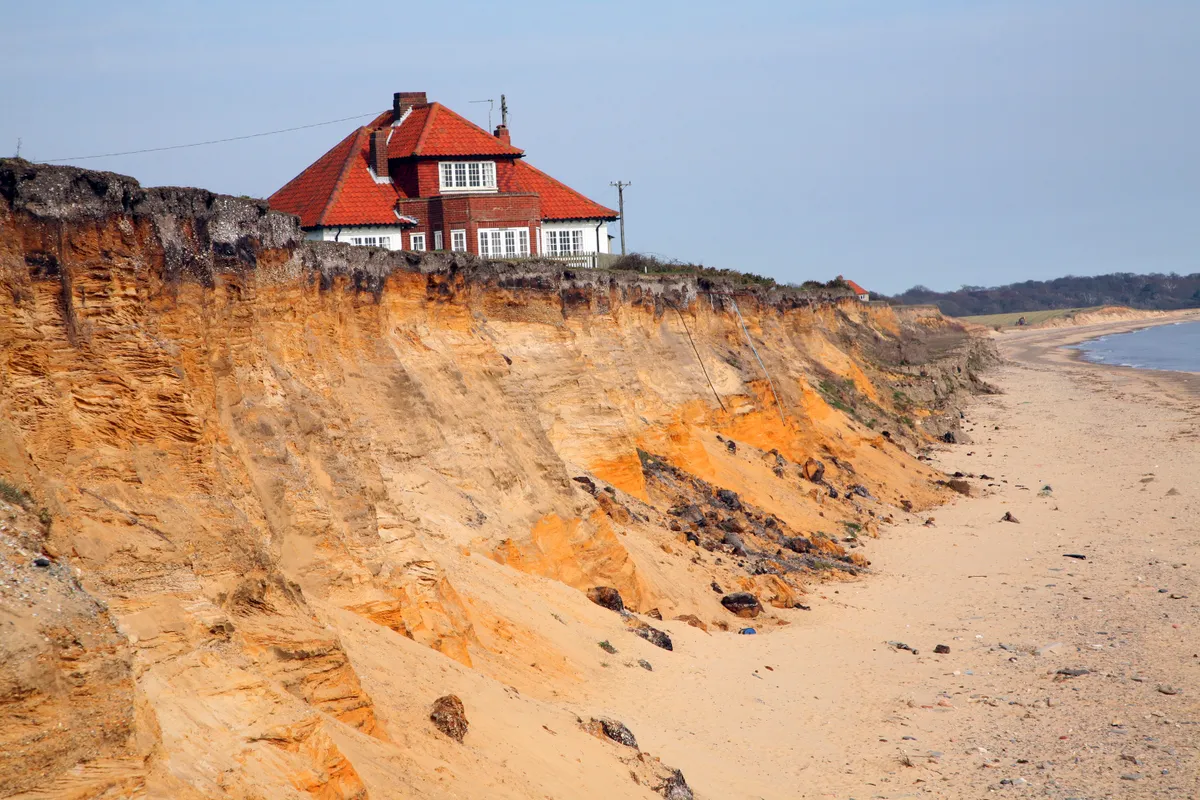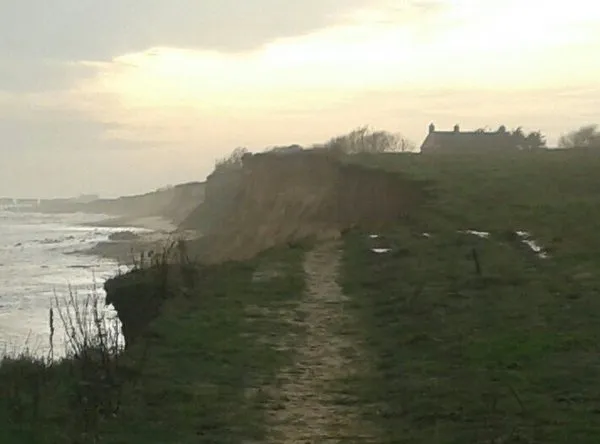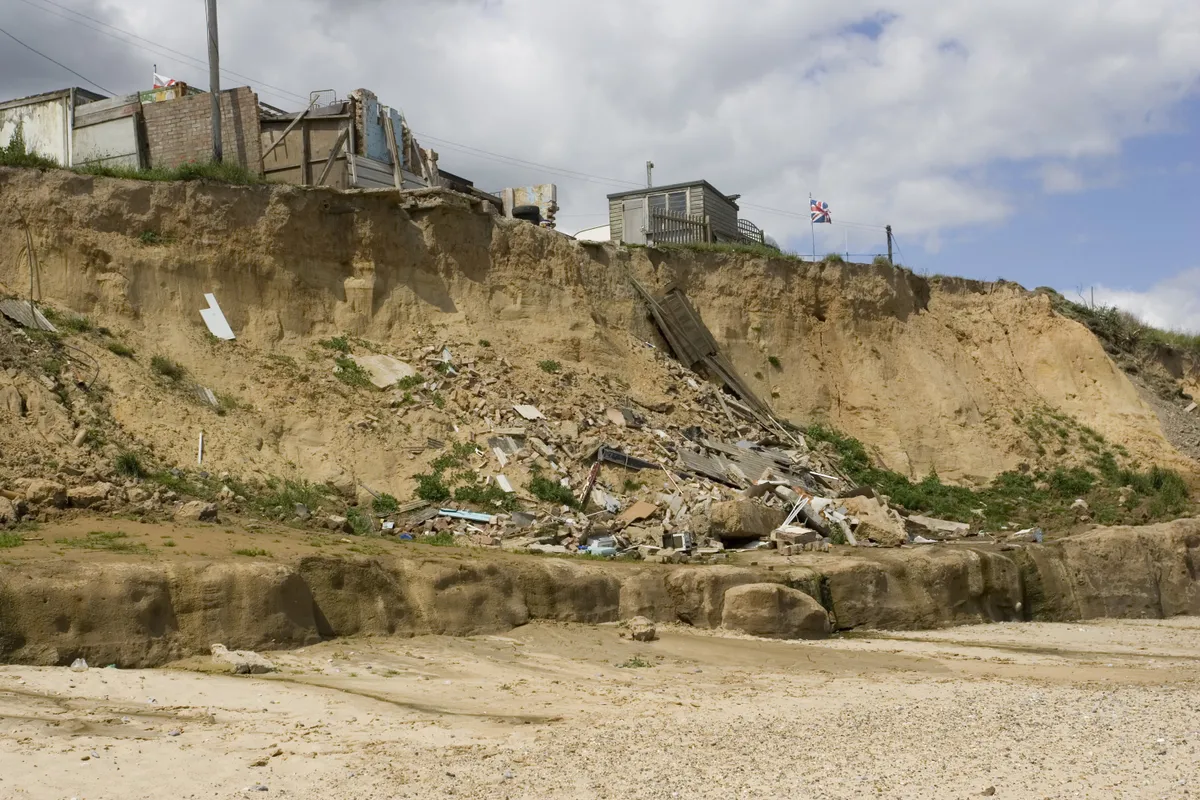Juliet Blaxland lives on a crumbling cliff-edge in Suffolk in a hamlet called Easton Bavents. Once an important village with a market, coastal erosion is causing it to slowly disappear into the sea. The village church disappeared into the sea three centuries ago and it won’t be long before Juliet’s home (‘called The Easternmost House’) goes the same way.
Her book, The Easternmost House, begins in January when the house is 24 metres from the cliff edge. By the end of the year, and the end of the book, there are only 20 metres left. Here she reveals what life is like living on a crumbling cliff edge.
We live in a windblown house on the edge of an eroding clifftop at the easternmost end of a track which leads only into the sea. The farm track looks as if it wants to continue for a mile or two, but it has been hacked off roughly by the wind and sea and erosion. There used to be a village here, and there used to be several hundred more acres of farmland. This farm used to own the easternmost land mass in the whole of Britain, and the little village used to be at the heart of the easternmost parish: Easton Bavents, Suffolk.

The house on the edge of the cliff was demolished this week, which means we are now the house on the edge of the cliff.
Juliet Blaxland, author of The Easternmost House: A Year of Life on the Edge of England
The word “east” appears three times in our Easton Bavents address, four if you add Easton Farm, and five if you count the fact that we are in East Anglia. There is much here that “used to be”, and it seems sad and unromantic that the actual easternmost point of Britain is now an uncelebrated spot in Lowestoft. Soon, the house we live in will be described as the house that “used to be” right on the edge. The jagged edge is always a warning, of recent erosion, of unknown cliff conditions underfoot, of new chunks of land having fallen into the sea overnight.

When we first moved here, there was a house on the edge of the cliff, and about fifty paces to the edge. Now, there are more like twenty paces. We are beginning to adjust our lives and plan for the demolition, before the house is lost to the sea and we must move. We rent the house from the farm, so the main financial loss is to the farm, along with loss of land and loss of crops, mainly Maris Otter barley for Adnams beer, visible across the fields.
The view from the house and the cliff is a distant postcard view of Southwold, but the cliff is a wild place, bashed about by raw nature. In summer it can be like living in a Mediterranean paradise. In winter it can be living on a wind-lashed trawler. The Suffolk coast is eerie and deceptive like that. It looks pretty, but it hides many ways to cast tragedy over the unwary or the over-confident on their summer holidays. An RNLI sign on the side of the Lifeboat Station down at the harbour warns that “8 dogs”, crossed out, “9 dogs” have recently fallen into the river. Land, sea and sky are unheeding of the line in the hymn, “its own appointed limits keep”. Here, the “mighty ocean deep” keeps to no appointed limits.
Usually the erosion is gradual and predictable, but sometimes there is a sudden cliff collapse. Two reedcutters told me that the Benacre estate, a mile or so to the north, had lost sixteen metres in one tide. Once, a whole dune disappeared overnight. In one tidal storm surge, a sandy bay formed on our beach. One night, there was a vast electric storm of horizontal lightning, lighting up the whole barley crop as if in daylight, but with an odd eerie light in the manner of an imagined nuclear explosion. Rarely, the green sky of Northern Lights can be seen from this farm.

One day, quite soon, the yellow digger will destroy the walls where our familiar pictures hang. Then the sea will finally come, and it will devour without gratitude the ancient piece of cliff upon which the house now sits, and this place where we have known a happiness beyond contentment will exist only as only a particular volume of sky over the sea.
What have I learnt from living on the edge of a crumbling cliff…?
- Appreciate the everyday beauty of nature in the ordinary things: grasses, weeds, insects, common crops, farm animals and wildlife, and in the city, those tiny plants that grow between the cracks in concrete.
- Rather than seeing coastal erosion and violent storms as destructive, such power can give us hope, that the mighty forces of nature can heal the damage done by human life in the past half-century, that in the long term and in the grand scheme of things, nature is so much greater than us that perhaps there is only so much damage we can do.
- The tide turns. Whatever happens in individual lives, the seasons come round again and spring will follow winter as surely as the sun will rise every dawn. This too will pass. The tide may have turned in our damaging relationship with nature, and the worst may be over. We have realised the errors of our ways. We may have passed peak plastic, peak consumerism, peak pollution.
- Animals seem to need something like a sense of humour, or at least playfulness, to thrive.
- Every harvest time, there will be photographs in the national press, showing straw bales captioned ‘hay bales’. But hay and straw are very different – reinforcing a media world disconnected with nature and farming. But this disconnection can be reversed too; it wasn’t long ago that burning the stubble was common. Now we live in more enlightened times.
- Everyone has a cliff coming towards them; the difference is we can see ours. With a visible loss of land marking a decade of your life having ‘gone’, it is impossible not to see in the approaching cliff edge a metaphor for your own mortality, and yet, in the vastness of this wild environment, it is equally easy to see death as just an everyday act of natural recycling, and nothing to be afraid of at all. We have been there before.
On that cheery note, I hope you enjoy reading The Easternmost House.
The Easternmost House: A Year of Life on the Edge of England
By Juliet Blaxland
Published by Sandstone Press, April 2019 (c/o Graham Maw Christie literary agency)
#TheEasternmostHouse
